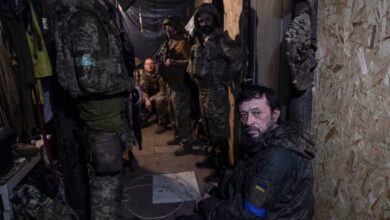
A Russian warplane dropped a bomb on a Russian city of more than 400,000 people late Thursday, leaving a crater 20 meters (65 feet) across, blowing a car onto a roof and damaging buildings in what state media called an “accidental” or “emergency” release of air ordnance.
A Russian Su-34 aircraft, a twin-engine fighter-bomber, was performing a flight over the city of Belgorod, 40 kilometers (24.8 miles) north of the border with Ukraine when the “accidental” drop of munition took place, according to reports from state news agency RIA Novosti.
“At around 22:15 Moscow time on April 20, when a Su-34 plane of the Russian Aerospace Forces was performing a flight above the city of Belgorod, an emergency release of an air ordnance occurred,” TASS quoted the Russian Defense Ministry as saying.
“It happened at the intersection of one of the central streets, leaving a huge impact crater with a radius of 20 meters,” Vyacheslav Gladkov, governor of the Belgorod region, said in a Telegram post.
An overturned car landed on the roof of a store, according to RIA Novosti.
Belgorod Mayor Valentin Demidov wrote on his Telegram channel that several apartment buildings were damaged in the blast.
Two people were reported injured in the explosion, Gladkov said.
Russian state media boasted about the country’s Su-34 warplanes last December, when it said a “new batch of … frontline bombers” had been delivered to Russian forces to use against Ukraine. It did not give a specific number of planes delivered.
“The Su-34 bomber will constitute the basic strike power of Russian frontline aircraft. The upgraded Su-34 warplane features extended combat capabilities enabling it to employ advanced air-launched munitions, increase the range of striking ground and naval targets and expand the conditions and accuracy of bombing runs,” a TASS report at the time said.
The planes can carry a variety of munitions, including air-to-air and air-to-surface missiles as well as guided and unguided bombs.
Russia state media did not say what kind of munition fell on Belgorod late Thursday.
Moscow’s Su-34 fleet has seen significant losses since the war began, with 10% or more destroyed by some estimates. The Netherlands-based open source intelligence website Oryx says it has visual evidence of 19 of the planes lost in both combat and non-combat instances.
‘Odd’ circumstances, analyst says
Peter Layton, a visiting fellow at the Griffith Asia Institute and former Royal Australian Air Force officer, said a pilot may jettison bombs when their aircraft loses power, or in the case of an Su-34, losing power in one of its two engines.
But he termed Thursday’s Belgorod incident “odd” for several reasons.
Firstly, the munition exploded. In an emergency, ordnance would normally be released in a “safe” mode so it wouldn’t detonate, unless “the bomb’s explosive filing is very sensitive to shock.”
Secondly, a pilot would normally jettison a bomb in unpopulated areas.
“Where the bomb hit; the town center, not in the countryside, almost suggests accuracy,” Layton said.
Thirdly, if there were a problem, a warplane would be expected to jettison all munitions, not just one. “Maybe they were but only one exploded,” Layton said.
The Belgorod region has been the scene of several explosions and bombings since Russia’s invasion of neighboring Ukraine in February 2022.
Earlier this week, a village in the region, on the border with Ukraine, was struck by Kyiv’s forces, Gladkov claimed in a Telegram post.
Local media reported two drones dropped small bombs at the local thermal power plants, citing an anonymous source.
Ukraine would not confirm its involvement in that incident.
“We will not confirm or deny [Ukraine’s involvement],” a representative of the Defense Intelligence of Ukraine, Andrii Yusov, said in comments broadcast on Ukrainian national television on Monday.
“I think that Russians should get used to the fact that while they are waging an unjust war of aggression, there are no safe places on their territory.”
“The war has already come to the home of every Russo-fascist and every subject of the Russian regime,” he added.
This story has been updated to correct the size of the bomb crater in Bolgorod, according to Russian officials.




